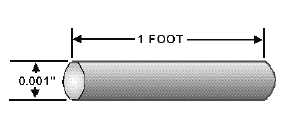1-4
A wire in its usual form is a single slender rod or filament of drawn metal. In large sizes, wire
becomes difficult to handle. To increase its flexibility, it is stranded. Strands are usually single wires
twisted together in sufficient numbers to make up the necessary cross-sectional area of the cable. The
total area of stranded wire in circular mils is determined by multiplying the area in circular mils of one
strand by the number of strands in the cable.
Q5.
Define a circular mil.
Q6.
What is the circular mil area of a 19-strand conductor if each strand is 0.004 inch?
CIRCULAR-MIL-FOOT
A circular-mil-foot (figure 1-3) is a unit of volume. It is a unit conductor 1foot in length and has a
cross-sectional area of 1 circular mil. Because it is a unit conductor, the circular-mil-foot is useful in
making comparisons between wires consisting of different metals. For example, a basis of comparison of
the RESISTIVITY (to be discussed shortly) of various substances may be made by determining the
resistance of a circular-mil-foot of each of the substances.
Figure 1-3.—Circular-mil-foot.
In working with square or rectangular conductors, such as ammeter shunts and bus bars, you may
sometimes find it more convenient to use a different unit volume. A bus bar is a heavy copper strap or bar
used to connect several circuits together. Bus bars are used when a large current capacity is required. Unit
volume may be measured as the centimeter cube. Specific resistance, therefore, becomes the resistance




